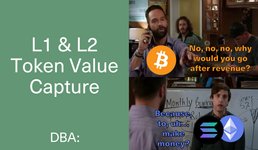
L1 & L2 Token Value Capture - DBA

When people argue that “issuance is a cost” in PoS networks, it’s usually a fuzzy attempt to get at “isn’t inflation bad for token value capture somehow? It seems like it should be bad, right?” However, the only real expense to token holders in aggregate is the payment made to operators. This is usually seen in staking commissions in PoS vs. PoW wh... See more
L1 & L2 Token Value Capture - DBA
Interestingly, Ethereum’s rollup-centric roadmap is implicitly a gambit in this direction. ETH is sacrificing REV to its L2s rather than capturing it all to itself, in return for spreading the moneyness of ETH the asset. It’s unclear if its L2s will win out, or if they’ll continue to aggressively use and spread ETH in the future, but it’s clearly t... See more
Jon Charbonneau • L1 & L2 Token Value Capture - DBA
Imagine that you own 100% of the tokens for a PoS network, and it issues 100% of new tokens to stakers. This makes it clear why it seems silly to tax this issuance. This looks like a stock split – it’s just a redenomination.
L1 & L2 Token Value Capture - DBA
In PoW, this isn’t too complex. Miners directly receive all TEV, of which issaunce is a real non-cash expense to token holders, similar to stock-based compensation in traditional finance. Miners are incentivized to expend an amount of energy (and money) which is roughly equivalent to the TEV available.
L1 & L2 Token Value Capture - DBA
Because of the high costs associated with running a Solana validator, you need quite a bit of stake to breakeven (either your own stake or delegated). The SFDP (Solana Foundation Delegation Program) exists to help get validators started and promote a healthy set of operators. This is done primarily with stake matching (up to 100k SOL) and helping t... See more
Jon Charbonneau • L1 & L2 Token Value Capture - DBA
Bitcoin is special. It was the first, and it’s still the most decentralized, credibly neutral, predictable, and reliable network. No other network can match its story, and perhaps no other will match these features.
Also, unlike most of its peers here, BTC makes no attempt to be a productive capital asset. Now, that may sound like a weakness at firs... See more
Also, unlike most of its peers here, BTC makes no attempt to be a productive capital asset. Now, that may sound like a weakness at firs... See more
Jon Charbonneau • L1 & L2 Token Value Capture - DBA
In a cryptonetwork, token holders would also be unwilling to supply capital at a loss indefinitely if the token’s only value is derived from its ability to generate profits in the future. However, this gets into the unique properties and value capture mechanisms of crypto – tokens may have value capture outside of their ability to produce income.
Jon Charbonneau • L1 & L2 Token Value Capture - DBA
For our purposes here, we will just draw a simple distinction between L1s and L2s:
- L1 – Network relies on its own dedicated operators.
- L2 – Network relies on the operators of another network. It may or may not have its own dedicated operators in addition to these.
Jon Charbonneau • L1 & L2 Token Value Capture - DBA
The sillier conversations have been happening on the PoS side. There are a lot more variables at play to get confused over, and we all want our own bags to be special. But we need to stop looking at silly metrics then drawing incorrect conclusions around sustainability. It’s silly to say that Solana is unprofitable or unsustainable. At most, you ca... See more